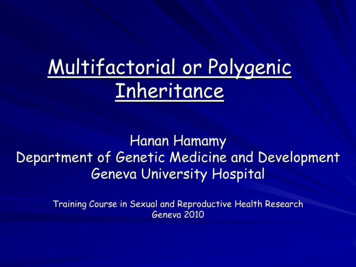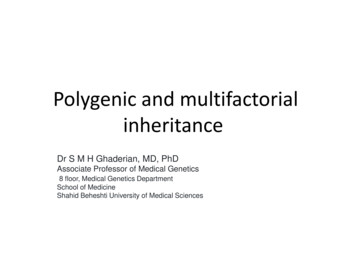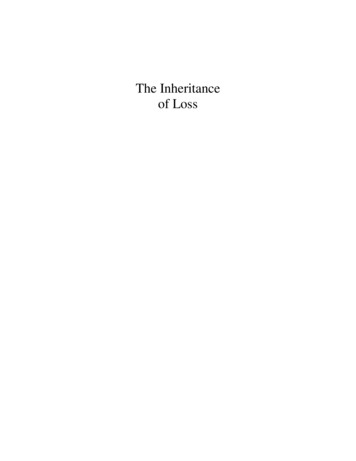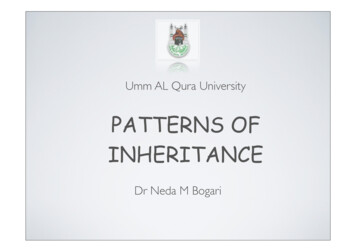
Transcription
Multifactorial or PolygenicInheritanceHanan HamamyDepartment of Genetic Medicine and DevelopmentGeneva University HospitalTraining Course in Sexual and Reproductive Health ResearchGeneva 2010
Spectrum of Human DiseaseHuman diseases are caused by a multitude ofgenetic and environmental factors actingtogether.In certain conditions such as Down syndrome ,genetic factors predominate, while in infectionsfor example, environmental factors predominate.Most chronic non-communicable conditions such asschizophrenia and diabetes as well as congenitalmalformations are caused by an interaction ofboth genetic and environmental factors.
Multifactorial inheritanceDiseases that show familial clusteringbut do not conform to any recognizedpattern of single gene inheritance aretermed multifactorial disorders.They are determined by the additiveeffects of many genes at differentloci together with the effect ofenvironmental factors.
Multifactorial disordersThese conditions show a definitefamilial tendency but the incidence inclose relatives of affected individuals isusually around 2-4%, instead of themuch higher figures that would be seenif these conditions were caused bymutations in single genes (25-50%).
Examples of disorders ofmultifactorial inheritanceCongenital malformations:congenital heart defectsneural tube defectscleft lip/palatepyloric stenosiscongenital hip dysplasiaCommon non-communicable diseases:asthmaschizophreniadiabetes mellitushypertension
Polygenic inheritanceThis involves the inheritance andexpression of a phenotype beingdetermined by many genes at differentloci, with each gene exerting a smalladditive effect.Additive implies that the effects ofthe genes are cumulative, i.e. no onegene is dominant or recessive toanother.
Multifactorial traitsSeveral human characteristics show acontinuous distribution in the generalpopulation, which closely resembles anormal distribution. This takes the formof a symmetrical bell-shaped curvedistributed evenly about a mean.
Polygenic / Multifactorial traitsA normal distribution(Gaussian or bell shapedcurve) is generated by manygenes, known as polygenes,each acting in an additivefashion.
Human characteristics that show a continuousnormal distributionHeightIntelligenceBlood pressureSkin colour
HeritabilityHeritability of a trait or disease is theproportion of the total variance that isgenetic.The overall variance of the phenotype isthe sum of the environmental and geneticvariance.Heritability provides information of theimportance of genetic factors in thecausation of the disease.
Examples of heritability estimatesSchizophreniaAsthmaPyloric stenosisIschaemic heart diseaseEssential hypertensionSpina bifidaDiabetes mellitus85807565606040
Liability curve and thresholdAccording to theliability/threshold model, all ofthe factors which influence thedevelopment of a multifactorialdisorder, whether genetic orenvironmental, can beconsidered as a single entityknown as liability.The liabilities of all individualsin a population form acontinuous variable, which canbe exemplified by a bell shapedcurve.Individuals on the right side ofthe threshold line representthose affected by the disorder.
ThresholdTo account for a discontinuous phenotype (i.e.affected or not affected) with an underlyingcontinuous distribution, it is proposed that athreshold exists above which the abnormalphenotype is expressed. In the generalpopulation the proportion beyond thethreshold is the population incidence, andamong relatives the proportion beyond thethreshold is the familial incidence.
Liability curves of affected and theirrelativesThe curve forrelatives ofaffected will beshifted to the right;so the familialincidence is higherthan the generalpopulation incidence.
Familial incidence versus generalpopulation incidenceThe risk of recurrence for first-degreerelatives, i.e. siblings and offspring ofan index case approximates to thesquare root of the general populationincidence.Thus if the incidence in the generalpopulation is 1 in 1000, the sibling andoffspring risk will equal approximately 1in 32 or 3% (square root of 1/1000).
Population and recurrence risks forType 2 diabetes mellitusIf incidence in the generalpopulation is 4-5%, then possiblerate of affection in first degreerelatives (brothers, sisters, sonsand daughters) is around 10-15%.
Liability curve and threshold
Liability or susceptibility for acertain disorderFor example : every embryo has a certainsusceptibility to cleft palate.The susceptibility is low or high and follows aGaussian distribution in the population.Embryos whose susceptibility exceeds a criticalthreshold value develop cleft palate, those whosesusceptibility is below the threshold develop a normalpalate.Susceptibility is the product of interaction of manygenes with environmental factors in utero.
Characteristics of multifactorialinheritancePolygenic threshold characters tend to run infamilies because affected individuals haverelatives who share their genes with them.Parents who have several affected childrenwill have more high risk alleles than parentswith only one affected child.Thus recurrence risk increases withincreasing number of previously affectedchildren.
Empiric risksRecurrence risks are empiric risksderived from population studies. Sothey are observational and do notdepend on theory as the Mendeliancharacters.Empiric risks vary according to severalfactors.
1- The incidence of the condition isgreatest among relatives of the mostseverely affected patients. If the index patienthas bilateral cleft lipand palate, the risk tofuture sibling is 6%.If the index patienthas unilateral cleft lip,the risk to futuresibling is 2%.
2- Recurrence risk increases with increasing number ofpreviously affected childrenIf a couple have a baby with neural tube defect,recurrence risk is about 2-4%. If they have 2children with neural tube defects, the recurrencerisk rises to 10%. It is not that having a second babycaused their recurrence risk to increase, but it makesthem a couple who always had been at a high risk. ForMF disorders, bad luck in the past is a predictor ofbad luck in the future.
3- The risk is greatest among closerelatives of the index case and decreasesrapidly in more distant relativesIn spina bifida the risks to first-, second- and thirddegree relatives of the index case are approximately4%, 1% and less than 0.5%, respectively.
4- If the condition is more common in individuals of oneparticular sex, recurrence risk varies according to sexof index casePyloric stenosis shows a male to female ratio of 5 to1. The threshold must be higher for girls than boys.Relatives of an affected girl must have a highersusceptibility than relatives of an affected boy.Offspring of male index patients are 6.4% risk forsons and 2.5% risk for daughters.The risks to the offspring of female index patientsare 22.9% for sons and 11.4% for daughters.
To be affected or not depends on a balancebetween the number and function of good andbad genes and environmental factors
ConclusionsMultifactorial disorders are morecommon than single gene andchromosomal disordersThey are caused by the interaction ofmany genes with environmental factors
ConclusionsOptimum preventive measures rely onavoidance of the bad environmentalfactors since avoidance of inheritingthe bad genes is at present not possible.These measures can be explainedthrough counseling such aspericonception and chronic noncommunicable diseases counseling.
Multifactorial inheritance Diseases that show familial clustering but do not conform to any recognized pattern of single gene inheritance are termed multifactorial disorders. They are determined by the additive effects of many genes at differen











